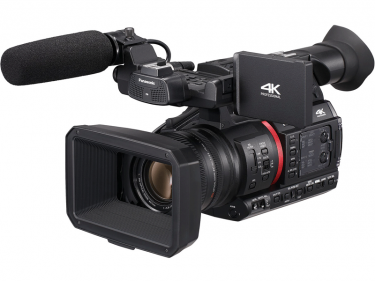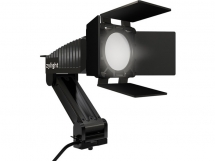| Українська | English | |||||||||||
|
|||||||||||
| News | About company | Service-centre | OB Van/SNG Rental | NextGen Energy Solutions | Contact us |
|
|
Engineering Service, Inc.
» News News Following with our test labs series, today at TM Broadcast it is our privilege to try the Panasonic AG-CX350. The lightest camera in its class does not spare in quality, boasting 4K-HDR support and other impressive features.
The big novelty about the CX30 is 4K-HDR recording capability with a 10-bit depth, which makes it a compact-format UHD camera. Additionally, by means of a simple WiFi dongle, or through a built-in Ethernet port, this camera allows RTMP/RTSP streaming transmission as well as IP signal transmission through the NDI-HX protocol. Let us look at it in more detail. Physical build and lenses The CX350 is truly compact. Not so much as its UX siblings, such as the UX90 or the UX180, but features are not the same either. If has three hand knobs on the lens, which enables controlling focuses, zooms and iris with a single hand. Furthermore, the body’s ergonomics enable using just one finger on each knob, which make this camera really comfortable and easy to operate. It comes with 8.8mm a wide-angle lens, which translates into 24.5mmm in 35mm. This results in the widest lens in its class, but with no aberration. Even in takes located really close to the lens –and also on the image edges- no distortion can be noticed, as well as in straight lines. Really amazing are its zooming capabilities. It features a 20x optical zoom, which reaches up to 32x in HD and 24x in UHD through its i.Zoom functionality. It is not a digital zoom, which would result in a decreased image quality -and which we never recommend using- but a smart zoom that allows impressive close-ups while maintaining resolution. In fact, if it were not for the fact that the i.Zoom performs zoom movements somewhat more slowly than a regular optical zoom, we would not realize we are using it at all. Of course, 2x, 5x and 10x digital zoom capabilities are also available, but we insist: using digital zoom should be something really occasional due to the resulting loss in quality. If we combine these zooming capabilities with the incredible hybrid stabilizer set at the highest level, the result is really impressive. I do not usually praise too much the products we have the opportunity to test as there is always something that needs improving, but this stabilizer by Panasonic is really good. This is a –as they call it- a 5-axis hybrid stabilizer, as in addition to stabilizing the image on the usual X, Y and Z axes, it performs an image analysis with stabilization of rotation and pitching as well. The result is very good. Event at maximum zoom levels by using the i.Zoom at 32x in HD, the image is seen 100% stable and when moving the view no sweeping effect occurs, something that is very typical in other stabilization systems. The system is able to correctly read the movement we intend to perform, thus moving the image the right way, with no undesired sweeping or ghosting. I even tried the system while riding a bike on a country path and holding the camera in one hand, and the result was very good. Undoubtedly, the distinct feature of the CX350 lies in the fact that it is a native HDR camera. The gamma curve used is HLG, which seems quite a wise move as this camera targets the broadcast market. If it were a camera targeting fiction or movie-making instead, I would be in doubt as to whether recommending said curve or other like a PQ10 or even Dolby Vision, but being intended for live broadcasts and HLG news, it is the perfect choice. Let us remind that HLG is backward-compatible with the BT.709 SDR curve, so no conversions are needed, which results in a simplified distribution workflow. It features a 15-megapixel 1.0-type MOS sensor offering great field depth and very good balance between quality and sensitivity. Besides, it does not cut the image when working at lower resolutions, which enables the lens to behave always the same way regardless of the format we are recording on. Thanks to this sensor, the camera is able to record slow-motion scenes by doubling frame-per-second speed in formats reaching up to HD. In 4K this is not possible as bandwidth required would be up to 800 Mbps depending on the recording format chosen. Recording formats As for recording formats, the maximum offered by the CX350 is under the HEVC LongGOP codec @ 200 Mbps. With a 4:2:0 sampling and a 10-bit depth, the device allows recording 2160p50 images at a really tight bit rate up to 150Mbps. If we want to perform postproduction on our images, my recommendation is to always select an intra-frame codec as it is much friendlier with the scene’s chrominance and enables color touch-up and much deeper image processing. To this purpose, we have the option of AVC at 400 Mbps with a 4:2:2 sampling and a 10-bit depth. It is self-evident that storage requirements will double and, in fact, XC SD cards are required for recording in this format, as these cards are faster than conventional HC SD cards, but our editing will appreciate the effort. Should we go for a compromise solution, we have at our disposal 8-bit options with bandwidths ranging from 100 to 150 Mbps already with AVC-LongGOP codec. In HD we also have a AVC codec for 10-bit depths and an AVC-HD codec for 8-bit depths at a minimum bit rate of 17 Mbps, ready for publishing. Space-related features These features are: • Compatibility with RTMP/RTSP streaming in HD. • IP NDI-HX output. RTMP/RTSP streaming Either through WiFi or by using the built-in Ethernet port connected to the Internet, the CX-350 allows for live-streaming directly to the Net with no need to resort to any other ancillary equipment. It comes pre-configured for YouTube and Facebook Live, but we can set up any desired RTMP or RTSP intake point by means of the right parameters. This provides an incredible versatility to this camera, as complex streaming workflows are avoided when production is simple or when dealing with news or similar broadcasts. IP NDI-HX output Although this is a Newtek proprietary protocol, Panasonic has decided to equip this camera with NDI-HX compatibility, which is just perfect for low-budget production environments. Unlike streaming, this feature only works on the built-in Ethernet port, and this makes perfect sense to me. Wireless WiFi networks inherently introduce some delay in data transmission, which it is simply unacceptable in a production environment. But bear one thing in mind. Both features, streaming through the internet and the NDI-HX protocol are only available in definitions up to HD. This turns out to be unfeasible in UHD in view of bandwidth and compression requirements. Conclusions The CX350 is a compact-format camera, but with features more usually found in higher-range devices. Recording stability –because of its high zoom rate and fantastic 5-axis hybrid stabilization system- makes nearly any take to turn out just perfect, thus avoiding the use of gimbals or similar devices. This is a real UHD camera, with an actual sensor definition of 10 megapixels, 4K-UHD and 10-bit depth. This makes possible capturing HDR-HLG takes, something ideal for broadcast and relay environments. However, it may not be the right choice if we want to use it for fiction or movie recording. Undoubtedly this camera is not intended for said purposes, but sometimes we need a compact camera for some scenes. And to top it all, it has truly novel features such as live streaming into any RTMP intake point, with default settings ready for Facebook Live and YouTube; as well as NDI-HD transmission, which makes it more than suitable for low-budget environments oriented to the Internet or simple productions. The CX350 surprised me as to image quality and for the two above features and it makes a good choice for IP-oriented environments, with a spectacular image quality. A great hit, I think. « To the list of news |
|
|||||||||||||||||
 |
+38 (044) 593-18-20 +38 (073) 593-18-20 +38 (096) 532-96-82 +38 (095) 532-96-82 Service center Telegram @Engineer_Service |

|
|
|||||
 |
e-mail: engineer-service.tv 15 Vavylovykh str., Kiev, 04060, Ukraine Authorized service centre of Panasonic, Sony, JVC, Fujinon, Canon |
|||||||








